When we think of house pets, cats often come to mind. But did you know that some of our feline friends are much larger than the typical house cat? In this article, we’ll explore the biggest house cats, their characteristics, and what makes them special. Whether you’re considering adopting a large cat or just want to learn more, this guide will provide you with all the information you need.
House cats, or domestic cats, are breeds that have adapted to living alongside humans. They are typically smaller than their wild relatives, but some breeds stand out for their size. These larger breeds not only have unique physical traits but also distinct personalities that can make them wonderful companions.
The Maine Coon is one of the largest domestic cat breeds, renowned for its impressive size, luxurious coat, and friendly demeanor. Originating in the United States, this breed has captured the hearts of cat lovers worldwide with its unique blend of physical beauty and charming personality.
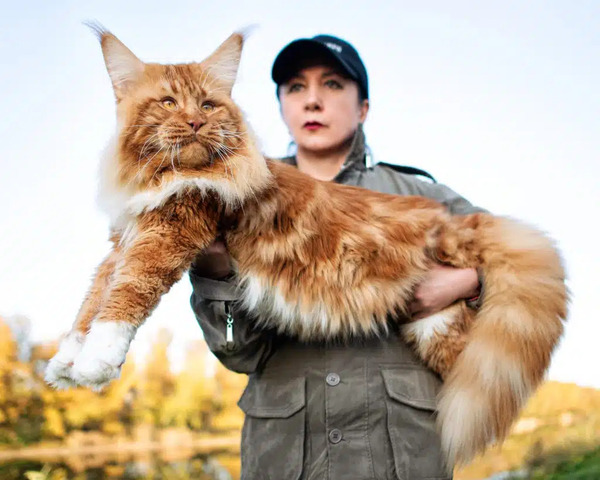
Size:
Maine Coons are among the largest domestic cats, with males typically weighing between 13 to 18 pounds (5.9 to 8.2 kg) and females ranging from 8 to 12 pounds (3.6 to 5.4 kg). Some individuals can even exceed 25 pounds (11.3 kg).
Coat:
They have a long, thick, and water-repellent fur coat, which is designed to protect them from harsh weather. Their fur is softer and lighter in texture than that of many other long-haired breeds. Maine Coons have a ruff of fur around their neck, resembling a lion's mane.
Face and Ears:
Maine Coons have a distinctive appearance with a broad, square-shaped head and high cheekbones. Their large, tufted ears often have fur that extends from the tips, enhancing their wild look.
Tail:
Their long, bushy tails are often as long as their bodies, and they can curl it around themselves for warmth.
Friendly and Affectionate: Maine Coons are known for their gentle and loving nature. They are often described as "dog-like" because they enjoy following their owners around and being involved in family activities.
Social and Playful: These cats are highly social and get along well with children and other pets. They enjoy interactive play and can be quite playful throughout their lives.
Intelligent and Curious: Maine Coons are intelligent and curious creatures. They often learn quickly and enjoy puzzle toys or games that challenge their minds.
Calm Demeanor: Despite their size, they are usually calm and laid-back, making them great companions for families and individuals alike.
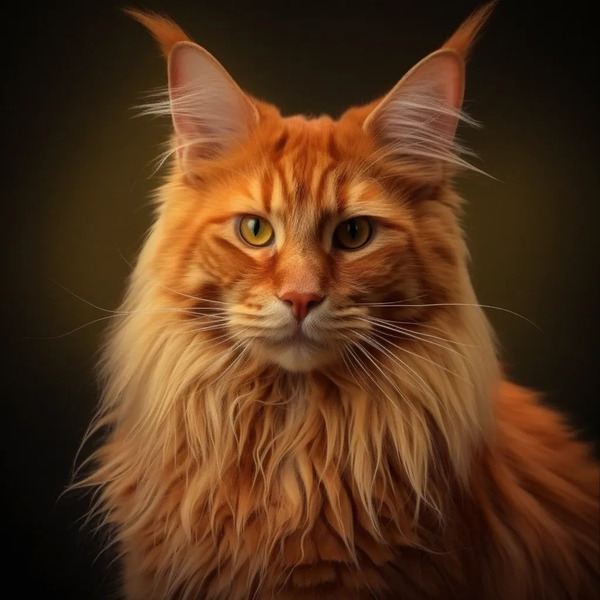
Grooming:
Regular grooming is essential to prevent matting and reduce shedding. A weekly brush is typically sufficient, though more frequent grooming may be needed during shedding seasons.
Diet:
Due to their size, Maine Coons may require a high-quality diet that meets their nutritional needs. Consult your veterinarian for recommendations on food types and portion sizes.
Health Care:
Regular vet check-ups are crucial, as Maine Coons can be prone to certain health issues, including hypertrophic cardiomyopathy (a heart condition) and hip dysplasia.
Exercise:
Providing plenty of opportunities for exercise is important. Maine Coons enjoy climbing, playing with toys, and interactive games that stimulate their hunting instincts.
The Maine Coon is truly a remarkable breed, combining size, beauty, and an affectionate nature. Their unique characteristics and playful personalities make them beloved companions for many families. If you’re considering adding a Maine Coon to your home, be prepared for a loving, loyal, and occasionally mischievous feline friend who will bring joy and warmth to your life.
The Savannah cat is a strikingly beautiful and unique breed that results from crossing a domestic cat with a serval, a wild African cat. This hybrid breed has gained popularity for its exotic appearance and lively personality, making it a favorite among cat enthusiasts.
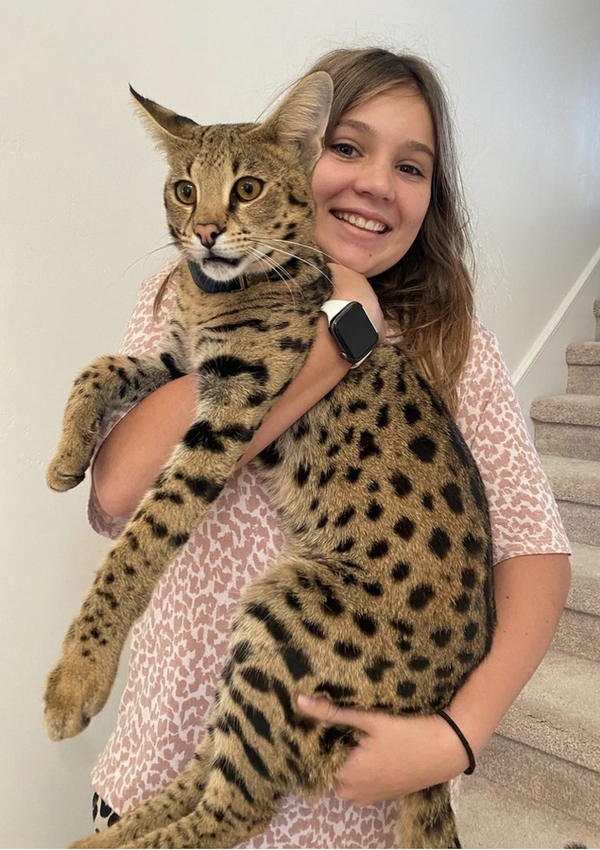
Size:
Savannah cats are known for their impressive size. They can weigh between 12 to 25 pounds (5.4 to 11.3 kg), with some individuals reaching even larger sizes. Males are generally larger than females.
Coat:
They have a short to medium-length coat that is soft and sleek. The coat is often adorned with distinct spots or marbled patterns reminiscent of their wild ancestors. The background color can vary, ranging from golden to silver and brown.
Ears and Eyes:
Savannahs have large, upright ears that are set high on their heads, giving them a wild look. Their eyes are almond-shaped and can be gold or green, adding to their striking appearance.
Body Structure:
These cats have long, muscular bodies with a lean appearance. They possess long legs, which contribute to their graceful and agile movements.
Intelligent and Curious: Savannah cats are known for their intelligence. They are highly curious and enjoy exploring their surroundings. They thrive on mental stimulation and can be trained to perform tricks or use a litter box.
Playful and Energetic: This breed is very active and playful, requiring plenty of physical exercise. They enjoy interactive play and can often be seen engaging in games that mimic hunting behavior.
Affectionate and Social: Savannahs are social creatures that enjoy spending time with their families. They often form strong bonds with their owners and can be quite affectionate. They tend to get along well with other pets, including dogs.
Loyal and Protective: Many Savannah cats exhibit dog-like loyalty to their owners. They may follow their humans around the house and may even “guard” them, showcasing a protective instinct.
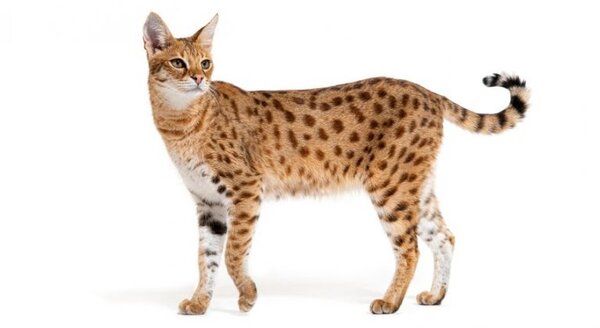
Grooming:
Savannah cats have relatively low grooming needs due to their short coats. Regular brushing can help minimize shedding and keep their fur in good condition.
Diet:
A high-quality diet is essential for maintaining their health, particularly because they have high energy levels. Consult your veterinarian for specific dietary recommendations.
Exercise:
Given their active nature, Savannah cats require plenty of exercise. Providing interactive toys, climbing structures, and opportunities for playtime is crucial for their well-being.
Socialization:
Early socialization is important for Savannah kittens to develop into well-adjusted adults. Exposing them to different environments, people, and other animals can help ensure a friendly disposition.
It's important to note that ownership of Savannah cats may be subject to local laws and regulations, as they are a hybrid breed. Some places have restrictions on owning hybrid cats due to their wild ancestry. Always check your local laws before considering adopting a Savannah cat.
The Savannah cat is a fascinating breed that combines the beauty of a wild cat with the companionship of a domestic pet. With their striking appearance and lively personality, they can be wonderful companions for active families who can provide the love, attention, and exercise they need. If you’re considering adding a Savannah cat to your home, be prepared for an intelligent, affectionate, and playful addition to your family!
The Ragdoll is a popular breed known for its striking looks and gentle temperament. Developed in the 1960s in the United States, Ragdolls are recognized for their large size, stunning blue eyes, and distinctive color-point patterns. Their friendly and laid-back nature makes them an ideal choice for families and individuals alike.

Size:
Ragdolls are one of the larger domestic cat breeds. Males typically weigh between 15 to 20 pounds (6.8 to 9 kg), while females generally weigh between 10 to 15 pounds (4.5 to 6.8 kg). Some individuals can even exceed these ranges.
Coat:
They have a semi-long, soft, and silky coat that is plush and easy to groom. Their fur is often described as feeling like rabbit fur. Ragdolls are less prone to matting compared to other long-haired breeds, but regular grooming is still recommended.
Color and Patterns:
Ragdolls come in various color-point patterns, including color point, mitted, and bicolor. Common colors include seal, blue, chocolate, lilac, and red. Their striking blue eyes are a hallmark of the breed.
Face and Body Structure:
Ragdolls have a broad, rounded head with prominent cheeks and a slightly curved forehead. Their bodies are muscular and sturdy, with a long, bushy tail that is proportionate to their size.
Affectionate and Gentle: Ragdolls are renowned for their affectionate nature. They are often described as “puppy-like” because they enjoy following their owners around and being involved in family activities. Many Ragdolls are known to be lap cats, seeking out cuddles and attention.
Calm and Relaxed: This breed has a laid-back temperament, making them well-suited for families and individuals who prefer a more relaxed pet. Ragdolls are generally tolerant and patient, making them good companions for children and other pets.
Intelligent and Trainable: Ragdolls are intelligent cats that can learn commands and tricks. They can be easily trained to use a litter box or to play fetch. Their curiosity and playful nature also keep them engaged.
Social and Friendly: Ragdolls are social animals that thrive on companionship. They typically get along well with other pets and are not known to be aggressive. Their friendly disposition makes them great additions to multi-pet households.
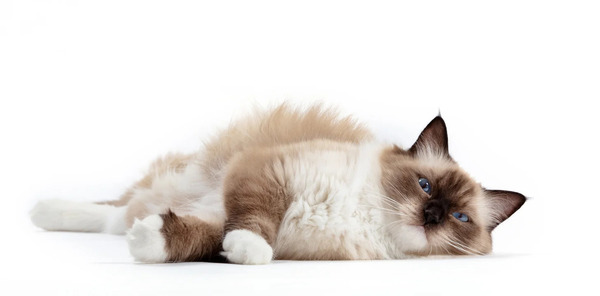
Grooming:
Regular grooming is important to keep their coats in good condition. Brushing them at least once a week can help reduce shedding and prevent matting.
Diet:
A balanced, high-quality diet is essential for Ragdolls, particularly to support their larger size. Consult your veterinarian for specific dietary recommendations based on your cat’s age, weight, and activity level.
Health Care:
Regular veterinary check-ups are important to monitor their health. Ragdolls can be prone to certain health issues, including hypertrophic cardiomyopathy (a heart condition) and bladder stones.
Exercise:
While Ragdolls are generally calm, they still need regular playtime and exercise to keep them healthy and happy. Interactive toys, feather wands, and climbing structures can help keep them active.
The Ragdoll is a stunning breed that brings joy and affection to any home. With their gentle nature, striking appearance, and loving personality, Ragdolls are well-suited for families, singles, and seniors alike. If you’re considering adding a Ragdoll to your household, be prepared for a loyal, affectionate companion that will quickly become a beloved member of your family!
The Norwegian Forest Cat, or "Norsk Skogkatt," is a robust and striking breed with a rich history that dates back to ancient Norse mythology. These cats are well adapted to the cold climates of Scandinavia, known for their beautiful fur, tufted ears, and friendly disposition. They are often described as gentle giants, making them wonderful companions for families and individuals alike.
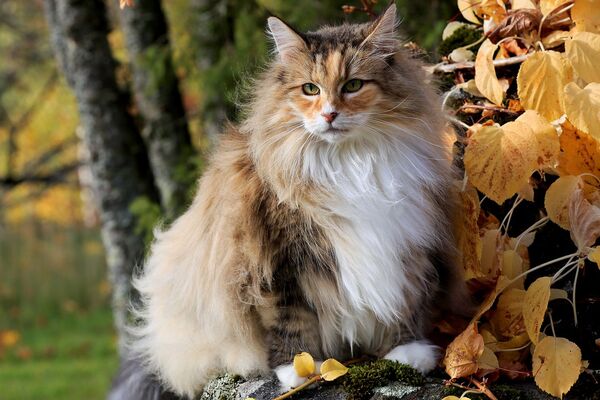
Size:
Norwegian Forest Cats are medium to large in size, with males typically weighing between 12 to 16 pounds (5.4 to 7.3 kg) and females weighing between 8 to 12 pounds (3.6 to 5.4 kg). Their muscular build and sturdy bone structure give them a solid appearance.
Coat:
They have a long, thick double coat that is water-resistant, providing insulation against harsh weather. The outer layer is coarse and guard hairs help repel water, while the undercoat is soft and dense. Their fur varies in length, with longer fur around the neck and ruff, resembling a lion’s mane.
Ears and Eyes:
Norwegian Forest Cats have large, tufted ears that are wide at the base and taper to a point, enhancing their wild appearance. Their eyes are almond-shaped and can be green, gold, or copper, adding to their striking look.
Body Structure:
These cats have a strong, muscular body with a broad chest and powerful legs. Their long, bushy tails are used for balance and warmth, particularly in cold climates.
Affectionate and Social: Norwegian Forest Cats are known for their friendly and sociable nature. They bond closely with their families and enjoy spending time with people. They are generally good with children and other pets.
Intelligent and Curious: This breed is highly intelligent and curious, often exploring their environment. They are quick learners and can be trained to follow commands or play interactive games.
Playful and Active: Norwegian Forest Cats are playful and enjoy engaging in activities that stimulate their minds and bodies. They love climbing, jumping, and playing with toys, so providing vertical spaces and playtime is important.
Calm and Easygoing: These cats typically have a calm and relaxed temperament, making them well-suited for various living environments. They are not overly demanding and can adapt well to different households.
Grooming:
Regular grooming is essential to keep their coat in good condition. Brushing at least once a week helps prevent mats and tangles, especially during shedding seasons when they may require more frequent grooming.
Diet:
A balanced, high-quality diet is crucial for maintaining their health. Norwegian Forest Cats benefit from a diet that supports their active lifestyle, and it's important to provide them with adequate nutrients.
Health Care:
Regular veterinary check-ups are important for monitoring their health. While generally healthy, Norwegian Forest Cats can be prone to certain genetic conditions, so responsible breeding practices are essential.
Exercise:
Providing opportunities for exercise is key to their well-being. They enjoy climbing cat trees, interactive toys, and games that challenge their agility and intellect.
The Norwegian Forest Cat is a majestic and loving breed that brings joy and companionship to any home. With their striking appearance, friendly disposition, and playful nature, they make wonderful additions to families and individuals alike. If you're considering welcoming a Norwegian Forest Cat into your home, be prepared for a loyal and affectionate companion that will quickly become a cherished member of your family!
The British Shorthair is one of the most popular and recognizable cat breeds, known for its sturdy build, round face, and dense coat. This breed has a rich history and a charming personality, making it a favorite among cat lovers worldwide. Here’s a comprehensive look at the British Shorthair, including its characteristics, history, care requirements, and more.
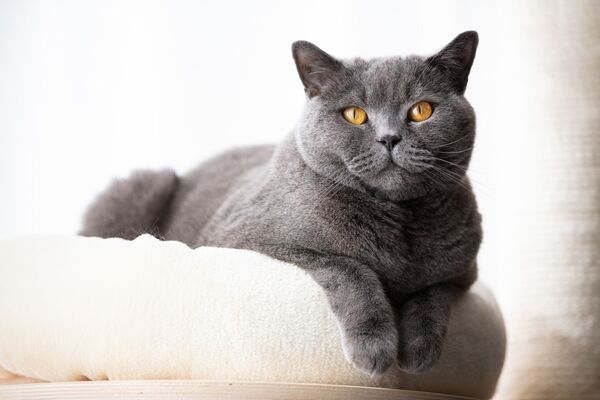
Build: British Shorthairs are medium to large cats with a muscular and compact body. They have broad shoulders, a deep chest, and strong legs, giving them a solid appearance.
Face: One of the most distinguishing features of the British Shorthair is its round face with full cheeks. They have a short, broad nose and large, round eyes that can come in various colors, including copper, gold, and blue.
Coat: The breed is known for its dense, plush coat, which is short but thick, providing a soft and cuddly texture. The coat comes in a variety of colors and patterns, with the most recognizable being the classic “British Blue,” a solid grayish-blue hue.
British Shorthairs are known for their calm and easygoing nature. They are typically friendly but not overly demanding, making them excellent companions. Here are some personality traits commonly associated with the breed:
Affectionate: They enjoy being around people and often form strong bonds with their owners. However, they are not clingy and appreciate their independence.
Playful: British Shorthairs retain a playful spirit well into adulthood. They enjoy interactive play and will often engage in games that stimulate their hunting instincts.
Gentle: This breed is known for its gentle demeanor, making them suitable for families with children and other pets. They tend to be tolerant and patient, which is a big plus in a multi-pet household.
The British Shorthair has a storied history that dates back to ancient Rome, where they were believed to have been bred from cats brought to Britain by Roman soldiers. These cats were prized for their hunting skills and adaptability to various environments.
In the late 19th century, the breed was officially recognized, and cat shows began to showcase their unique traits. The British Shorthair gained popularity in the early 20th century, and its iconic blue coat and round face became synonymous with the breed. However, the breed faced challenges during World War II, leading to a decline in numbers. Breeding programs after the war helped restore the breed, and it continues to be a beloved choice for cat enthusiasts today.
A balanced diet is essential for maintaining the health of a British Shorthair. High-quality cat food that meets their nutritional needs is recommended. Pay attention to portion control to prevent obesity, as this breed can be prone to weight gain.
British Shorthairs have a short, dense coat that requires minimal grooming. Regular brushing (once a week) can help reduce shedding and keep their coat healthy. Additionally, regular dental care, nail trimming, and ear cleaning are important aspects of grooming.
Like all breeds, British Shorthairs can be prone to certain health issues, including:
Hypertrophic Cardiomyopathy (HCM): A common heart condition in cats that can lead to serious health problems.
Obesity: Due to their laid-back nature, British Shorthairs can easily become overweight. Regular exercise and a healthy diet are crucial.
Regular veterinary check-ups are essential to monitor their health and catch any potential issues early.
The British Shorthair is a delightful breed characterized by its charming looks and easygoing temperament. With their affectionate nature and playful spirit, they make wonderful companions for families and individuals alike. If you’re considering adding a British Shorthair to your home, be prepared for a loyal friend who will bring joy and comfort to your life. With the right care and attention, this breed can thrive and be a beloved member of your family for many years.
Owning a larger cat comes with specific considerations:
Space: Ensure you have enough space for your cat to roam and play. Larger breeds need room to stretch and exercise.
Diet: Larger cats may require more food than smaller breeds. Consult your vet for dietary recommendations based on your cat’s size, age, and activity level.
Health Checkups: Regular vet visits are essential for monitoring your cat’s health, especially since larger breeds may be prone to specific health issues.
Playtime: Engage your large cat in regular playtime to keep them physically and mentally stimulated. Toys that mimic hunting behaviors are particularly beneficial.
Grooming: Some large breeds, like the Maine Coon and Ragdoll, require regular grooming to prevent matting and reduce shedding.
Here’s a comparative table showcasing the key characteristics of the Maine Coon, Savannah Cat, Ragdoll, Norwegian Forest Cat, and British Shorthair:
| Feature | Maine Coon | Savannah Cat | Ragdoll | Norwegian Forest Cat | British Shorthair |
|---|---|---|---|---|---|
| Size | Large (13-25 lbs) | Medium to large (12-25 lbs) | Medium to large (10-20 lbs) | Medium to large (12-16 lbs) | Medium to large (9-18 lbs) |
| Coat Type | Long, shaggy | Short to medium, soft | Semi-long, plush | Long, dense | Short, dense |
| Color Variations | Various colors and patterns | Various colors and spotted patterns | Various colors, including colorpoint | Various colors and patterns | Various colors, most recognizable blue |
| Face Shape | Square, with high cheekbones | Long and narrow | Round with full cheeks | Triangular | Round and broad |
| Eyes | Large and round, usually gold/green | Large, oval, gold/green | Large, round, blue | Large, oval, usually green | Large, round, various colors |
| Temperament | Friendly, social, playful | Intelligent, active, playful | Affectionate, gentle, calm | Friendly, playful, independent | Calm, easygoing, affectionate |
| Lifespan | 12-15 years | 12-20 years | 12-15 years | 14-16 years | 12-20 years |
| Grooming Needs | Moderate (weekly brushing) | Low (occasional brushing) | High (regular grooming needed) | Moderate (weekly brushing) | Low (weekly brushing) |
| Exercise Needs | High (enjoys play and activity) | Very high (requires stimulation) | Moderate (enjoys playtime) | Moderate to high (loves to climb) | Low to moderate (enjoys short play) |
| Best Suited For | Families, active households | Active individuals or families | Families, especially with children | Families, cat-friendly households | Families, individuals, first-time owners |
This table highlights the main differences and similarities among these popular cat breeds, helping potential cat owners choose the right companion for their lifestyle.
The biggest house cats offer a unique blend of beauty, personality, and companionship. From the friendly Maine Coon to the playful Savannah, these breeds can make excellent pets for those ready to accommodate their needs. If you’re considering bringing a larger cat into your home, remember to do your research and prepare for a loving, playful, and sometimes demanding companion. With the right care and attention, your big feline friend will bring joy and love into your life for years to come!
animal tags: Maine-Coon Savannah-Cat
We created this article in conjunction with AI technology, then made sure it was fact-checked and edited by a Animals Top editor.